
Ammonius is a bowl-shaped lunar impact crater with a slightly raised rim. It is located on the floor of the walled plain Ptolemaeus, about 30 kilometers northeast of the crater midpoint.

Artsimovich is a small lunar impact crater located in the western Mare Imbrium of the Earth's Moon. This is a circular crater forming a cup-shaped excavation in the surface of the lunar mare. It is named after Soviet physicist Lev A. Artsimovich. To the east is the crater Diophantus and to the northeast lies Delisle. Less than 20 kilometers to the north-northeast is the tiny Fedorov. This crater was identified as Diophantus A before being named by the International Astronomical Union.
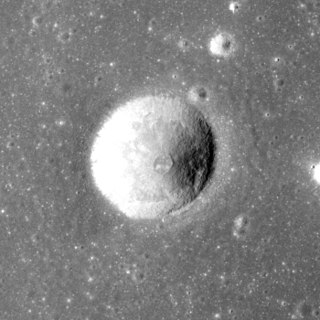
Borel is a tiny lunar impact crater located in the southeast part of Mare Serenitatis. It was named after French mathematician Émile Borel. To the northeast is the crater Le Monnier and to the southeast is the crater Abetti. Borel was previously identified as Le Monnier C.

Ching-Te is a small lunar impact crater located in a mountainous area to the east of the Mare Serenitatis. It is a circular, bowl-shaped formation with no distinguishing features.

Deseilligny is a small lunar impact crater in the southern part of the Mare Serenitatis. It was named after French selenographer Jules Deseilligny. It is located to the east-southeast of the crater Bessel. Deseilligny is a bowl-shaped crater with a low rim. It is otherwise undistinguished.

Finsch is a relatively small lunar impact crater in the mid-part of Mare Serenitatis that has been almost completely covered by the mare, forming a ghost crater in the lava plain. It was named after German zoologist Otto Finsch. It is located to the south-southeast of the crater Sarabhai and northeast of Bessel.

Bombelli is a small lunar impact crater that is located in the highlands to the north of the Sinus Successus. It was named after Italian mathematician Raphael Bombelli. It was previously designated Apollonius T. The crater Apollonius is located to the east-southeast.

Brewster is a small lunar impact crater in the northern fringes of Sinus Amoris. It was named after the Scottish scientist, Sir David Brewster. Its diameter is 9.8 km. It lies to the southwest of the larger crater Römer. To the southeast of Brewster is the similar-sized Franck. This crater is cup-shaped and symmetrical, with no overlapping craters of note. A low ridge is attached to the northern rim. The crater interior has a relatively high interior albedo compared to the surrounding terrain.

Littrow is a lunar impact crater that is located in the northeastern part of the Moon's near side, on the east edge of Mare Serenitatis. Its diameter is 29 km. The crater is named after Bohemian astronomer Joseph Johann Littrow. Some distance to the northeast is the prominent crater Römer, while to the south is Vitruvius.
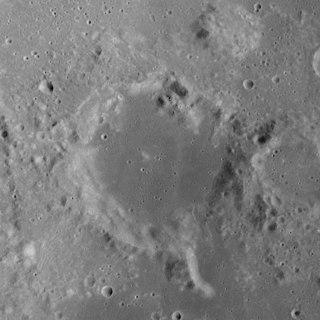
Maraldi is a worn, eroded crater on the western edge of the Sinus Amoris, in the northeast part of the Moon. To the west-southwest is the crater Vitruvius, and to the northwest lies the worn Littrow crater. Just to the northeast of the crater is the dome-like Mons Maraldi rise.

Boss is a lunar impact crater that is located along the northeast rim of the Moon's near side. Due to its location, the crater is viewed from the side by observers on the Earth, and its visibility is subject to libration effects.
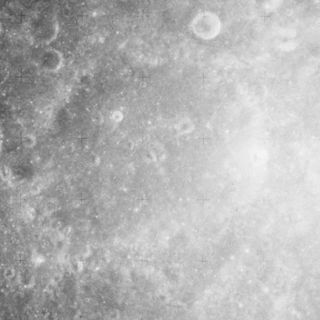
Buisson is a lunar impact crater that is located on the far side of the Moon. It is named after the French physicist Henri Buisson. Nearly attached to the southeast rim is the crater Vesalius. To the southwest is Einthoven. The rim of this crater is somewhat worn, and is lowest in the north. There is a low central ridge across the midpoint.

Courtney is a tiny lunar impact crater on the Mare Imbrium, a lunar mare in the northwest quadrant of the Moon. It lies about two crater diameters to the northwest of Euler, in an otherwise isolated stretch of the mare. The dark surface in this region is marked by Euler's ray material. The name is an English male name.
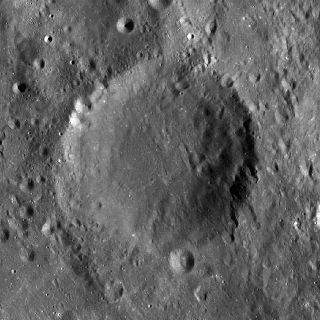
Chaucer is a lunar impact crater that is located to the west of the walled plain Hertzsprung, on the far side of the Moon. It lies to the northwest of the crater Vavilov and east of the Tsander–Kibal'chich crater pair. This is a circular crater with a slightly eroded outer rim. The interior floor is nearly featureless, with only a few tiny craterlets marking the surface. It is named after the writer Geoffrey Chaucer.

Robert is a tiny lunar impact crater in the southeastern part of the Mare Serenitatis. It is located to the northeast of the small crater Dawes, and to the west of the Montes Taurus range. To the east-northeast of this position is the landing site of the Apollo 17 mission, in the Taurus–Littrow valley.

Stella is a small lunar impact crater on the eastern side of Mare Serenitatis. It is a fresh crater with a prominent bright ray system. It is to the southwest of the larger Ching-Te, and west of the Taurus-Littrow valley where Apollo 17 landed in 1972.

Jerik is a tiny lunar impact crater in the southeastern part of the Mare Serenitatis. It is located to the northeast of the small crater Dawes, and to the west of the Montes Taurus range. To the east-northeast of this position is the landing site of the Apollo 17 mission, in the Taurus–Littrow valley.
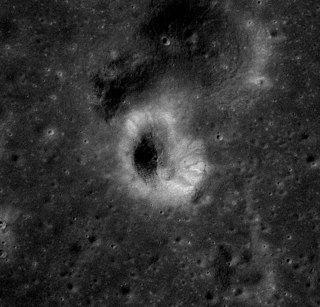
Mary is a tiny lunar impact crater in the southeastern part of the Mare Serenitatis. It is located to the northeast of the small crater Dawes, and to the west of the Montes Taurus range. To the east-northeast of this position is the landing site of the Apollo 17 mission, in the Taurus–Littrow valley.
Fibiger is a lunar impact crater located on the lunar near side near the northern pole. The nearest major feature is the Byrd crater. The crater was adopted and named after Danish pathologist Johannes Andreas Grib Fibiger in 2009 by the IAU. Located just north of Fibiger are craters Erlanger and Peary, which are 9.9 km and 73 km in diameter, respectively.
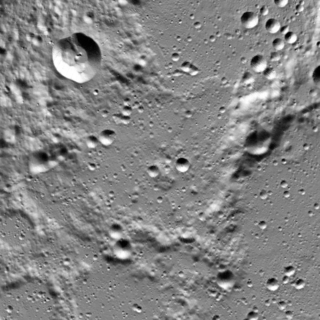
Florey is a lunar impact crater on the lunar near side near the northern pole. Florey is directly adjacent to Byrd crater to the Southeast and Peary crater to the North. The crater is named after Australian scientist Howard Florey. The crater was named by the IAU in 2009.






















